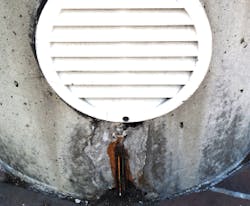Lack of Proper Maintenance
I found this problem in front of the Long Beach Convention & Entertainment Center, Long Beach, Calif., while attending the Electric West Show. The conduit protecting the conductors serving this lighting equipment is completely gone. And yes, these conductors were energized! The NEC does not guarantee that installations will last forever, so this type of problem is not uncommon. This installation could cause a serious accident.
As noted in 90.1(A), “The purpose of this Code is the practical safeguarding of persons and property from hazards arising from the use of electricity.” Section 90.1(B) goes on to say, “This Code contains provisions that are considered necessary for safety. Compliance therewith and proper maintenance results in an installation that is essentially free from hazard but not necessarily efficient, convenient, or adequate for good service or future expansion of electrical use.” The key words to focus in on in this sentence are “proper” and “maintenance.”
Extra Slack, For What?
I ran across this installation on the side of a government center train and bus station parking structure. The raceway was installed to supply power to relocated parking entrance signs and other advertisements located nearby.
Article 350 outlines the requirements for the safe installation of liquidtight flexible metal conduit (LFMC) and associated fittings. The Code defines LFMC as “a raceway of circular cross section having an outer liquidtight, nonmetallic, sunlight-resistant jacket over an inner flexible metal core with associated couplings, connectors, and fittings for the installation of electric conductors.”
LFMC shall be securely fastened in place and supported in accordance with 350.30(A) and (B). As noted in 350.30(A), “LFMC shall be securely fastened in place by an approved means within 300 mm (12 in.) of each box, cabinet, conduit body, or other conduit termination and shall be supported and secured at intervals not to exceed 1.4 m (4½ ft).”
LFMC is not designed to be used as shown here. For starters, it is lying across a gas line, which violates the support rules noted above. In addition, the installation is not neat and workmanlike as required by 110.12. Another section of the NEC worth reviewing with this type of installation focuses on the bend requirements for LFMC (350.24).
About the Author
Joe Tedesco
Tedesco served the industry in many roles during his career. He was a director, senior electrical code instructor for National Technology Transfer, Inc. and American Trainco, Inc.. He was also a codes, standards and seminar specialist for the International Association of Electrical Inspectors and an electrical field service specialist for the National Fire Protection Association in Quincy, Mass. He ran his own business as an NEC consultant and is a Massachusetts licensed master electrician and journeyman electrician and certified electrical inspector (one and two family 2A; General 2B, and Plan Review, 2C). Tedesco also wrote articles for CEE News and EC&M (Code Violations Illustrated and What's Wrong Here?) for more than 15 years and helped launched the Moving Violations video series.
